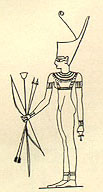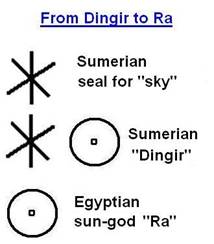Rakovsky
Active Member
Currently scholars do not have a consensus on the origin of the meaning of NTR. This is the Egyptian word for God, for a deity, or for a divine object. It is spelled NTR in hieroglyphics and pronounced Neter.
Some scholars post the theory that NTR means nature, element, or principle.
One reason they do so is because commonly in practice there are gods associated with various elements or principles. For example, there is a "god" of the sun - Ra, a "god" of justice, a "god" of the earth - Geb, a "god" of the primordial waters. Each of these "gods" were often given different stories or myths, like Ra riding a barque in the heavens.
For example, Shingai Rukwata Ndoro writes in the Sunday Mail (June 14, 2015):
Francisco Tomás Verdú Vicente talks about famous Egyptologist Budge's view in the journal MEDICINA NATURISTA, 2011; Vol. 5 - N.º 2: 80-81, and associates NTR with Nature:
The book Religion and the Order of Nature by Seyyed Hossein Nasr (Professor of Islamic Studies at George Washington University) says:
And a review of the book The Temple in Man by R.A. Schwaller de Lubicz says:
To give another example, from the name of the god "Hor" (in English Horus), the falcon who was the sun bringing the dawn on the horizon, some words have come into English:
"In time Hor became part of the Latin language and found its place in words such as “horizon”, “horizontal”, “horoscope” and even “hour” in English and “heure” in French."
http://www.astroset.com/bireysel_gelisim/ancient/a22.htm
And to give a third example, a central Egyptian god was Ammon, the God of Thebes, Karnak, and Luxor, whose name Ammon means "the Hidden One". Wikipedia says about this:
And so one might think that NTR came into Latin as Natura, and then into English as Nature. It's interesting that in Coptic and Egyptian dictionaries we do not find a translation for the English word "nature". Could NTR be that word?
There are several weaknesses to this theory that NTR is "nature". First, the scholars I cited above, with the exception of Budge, are not major Egyptologists.
Secondly, words may appear similar across languages yet have very different meanings. What is pronounced and written "God" in Russian means "year", while in English, "God" means Deity or "the Divine One". In the case of Natura in Latin, it is commonly thought to be a form of the word Natalis, which means "to give birth". So the resemblance between Natura and NTR could be a coincidence.
Third, while it's true that the sun, earth, justice, etc. might be principles or elements, this does not really explain an etymological origin for NTR. That is, how does one go from the concept of elements or principles to phonetically producing the word NTR?
Fourth, in Egyptian thought, the neteru (gods) are not simply elements or principles, but at least within the mythology they are also sentient beings. That is, Ra (literally "sun") is not just the physical sun, but he also interacts with various other deities like Isis, Osiris, and Horus in several myths.
What do you think of this theory that NTR = Natura or Nature?
In the next message I will explain my own theory that NTR = NT + R, that is, the Heavens goddess + the Sun god.
Some scholars post the theory that NTR means nature, element, or principle.
One reason they do so is because commonly in practice there are gods associated with various elements or principles. For example, there is a "god" of the sun - Ra, a "god" of justice, a "god" of the earth - Geb, a "god" of the primordial waters. Each of these "gods" were often given different stories or myths, like Ra riding a barque in the heavens.
For example, Shingai Rukwata Ndoro writes in the Sunday Mail (June 14, 2015):
There was in fact a myth in Egypt as she says that 8 primordial deities, four pairs of males and females, existed before the Creation was formed into the world we know it. So for example one pair was Nun/Nunet, referring to the primordial waters.Neteru is the plural for the ancient Egyptian divinity or sum of divine energies. The hieroglyph for ‘Ntr’ looks like a flag. ‘Ntr’ is also the force of nature (from Latin, ‘natura,’ which means “birth, essence”). The ancient Egyptian sum of divine energies (“neteru”) humanised aspects of an impersonal cosmic energy or life force whose behaviour created and sustains life and the universe. Attributes and functions of such an impersonal cosmic energy or life force were also presented as animals. Contrary to a falsified explanation, ancient Egyptians did not have numerous divinities but they humanised the various attributes of the cosmic energy or life force, the One (the duality of “Neter-Netert”) in the All (“Neteru”).
According to the 17th chapter of the “Book of the Dead,” the First Order and Cause of Nature consisted of eight cosmic energies (Neter-Netri) (NTR) or divinities.
http://www.sundaymail.co.zw/origins-of-miraculous-conception-in-ancient-egypt
Francisco Tomás Verdú Vicente talks about famous Egyptologist Budge's view in the journal MEDICINA NATURISTA, 2011; Vol. 5 - N.º 2: 80-81, and associates NTR with Nature:
https://dialnet.unirioja.es/descarga/articulo/3695453.pdfThe term nature comes from the word Egyptian ntr and it means God... The notion expressed by nutar as substantive and nutra as adjective or verb should be looked for in the coptic Nout...
Wallis Budge, the great Egyptologist that he was, recognized something fundamental about the word natura: "Another definition of the word [NTR], given by Brugsch, means 'active energy that produces and creates things regular recurrence; which gives them new life and gives them back their youthful vigor' and adds that the innate concept of the word completely covers the φυσιζ original meaning of the Greek word and Latin natura.
The book Religion and the Order of Nature by Seyyed Hossein Nasr (Professor of Islamic Studies at George Washington University) says:
...there are basic principles concerning the order of nature that continue through these transformations, such as the identification of cosmic elements with real divinities possessing a personal existence. Most important of these principles for the understanding of the order of nature is the Neter , which has received many interpretations, some even equating it with the Hebrew Wl. The Neter is a principle conveyed by a sign, the hieroglyph being itself called Medu-Neteru. It is the Idea of which a material object is the crystallization.
...
The order of nature is the reflection of the order that belongs to the realm of the principles or Neteru, which man also carries within his being as a consequence of his central position in the cosmic order. 'Every natural type is a revelation of one of the natures and abstract functions that rule the world, a verb of the divine language —that is, the entities or fully realized Principles (Neteru).
And a review of the book The Temple in Man by R.A. Schwaller de Lubicz says:
It's true that some words have come from Egyptian into Western languages. Natron is a chemical, symbolizes as Na, which is a sodium carbonate that was used to preserve mummies. Egyptians thought that the souls of the deceased could become Gods (Neteru). "Natron" is both the same word in English and in Egyptian. It came into English through Greek (as Nitron) and Latin (as Natrium), probably originally from Egyptian.Schwaller de Lubicz explains in Le Temple de l'Homme (Caracteres, 1957) that in the ancient temple civilization of Egypt, numbers, our most ancient form of symbol, did not simply designate quantities but instead were considered to be concrete definitions of energetic formative principles of nature. The Egyptians called these energetic principles Neters, a word which is conventionally rendered as "gods." To conform with the true meaning of the symbol in ancient Egypt, we ought to use the Egyptian term Medu-Neteru, the Greek translation of which, "heiroglyphs," distorts the Egyptian meaning. Medu-Neteru are the Neters, or the principles conveyed by a sign.
...
"'Divine" man (without this part of the brain ) represents the Principle or Neter, capable of living and acting, but only as the executant of an impulse that he receives; hence, he plays the role of an intermediary between the abstract impulse, outside of Nature, and its execution in Nature, without actual choice. In this regard, this entity has a primitive, and "prenatural" character...
...each of these individual members of the vegetable kingdom belongs to a genus, and this genus to a family; and these families belong to an original "lineage." At the head of this lineage is a Neter, a "Principle" synthesizing all the characteristics of this lineage: its number, its rhythm, its classification in the general harmony. Let us further elucidate, by means of a geometrical image, the role of the Neter as head or Principle of a lineage.
http://www.fatuma.net/text/R.A.Schw...einMan-SacredArchitectureandthePerfectMan.pdf
To give another example, from the name of the god "Hor" (in English Horus), the falcon who was the sun bringing the dawn on the horizon, some words have come into English:
"In time Hor became part of the Latin language and found its place in words such as “horizon”, “horizontal”, “horoscope” and even “hour” in English and “heure” in French."
http://www.astroset.com/bireysel_gelisim/ancient/a22.htm
And to give a third example, a central Egyptian god was Ammon, the God of Thebes, Karnak, and Luxor, whose name Ammon means "the Hidden One". Wikipedia says about this:
https://en.wikipedia.org/wiki/Ammonia#HistoryThe Romans gave the name sal ammoniacus (salt of Amun) to the ammonium chloride deposits that they collected near the Temple of Amun (Greek Ἄμμων Ammon) in ancient Libya.[26] Salts of ammonia have been known from very early times; thus the term Hammoniacus sal appears in the writings of Pliny,[27] although it is not known whether the term is identical with the more modern sal ammoniac (ammonium chloride)
And so one might think that NTR came into Latin as Natura, and then into English as Nature. It's interesting that in Coptic and Egyptian dictionaries we do not find a translation for the English word "nature". Could NTR be that word?
There are several weaknesses to this theory that NTR is "nature". First, the scholars I cited above, with the exception of Budge, are not major Egyptologists.
Secondly, words may appear similar across languages yet have very different meanings. What is pronounced and written "God" in Russian means "year", while in English, "God" means Deity or "the Divine One". In the case of Natura in Latin, it is commonly thought to be a form of the word Natalis, which means "to give birth". So the resemblance between Natura and NTR could be a coincidence.
Third, while it's true that the sun, earth, justice, etc. might be principles or elements, this does not really explain an etymological origin for NTR. That is, how does one go from the concept of elements or principles to phonetically producing the word NTR?
Fourth, in Egyptian thought, the neteru (gods) are not simply elements or principles, but at least within the mythology they are also sentient beings. That is, Ra (literally "sun") is not just the physical sun, but he also interacts with various other deities like Isis, Osiris, and Horus in several myths.
What do you think of this theory that NTR = Natura or Nature?
In the next message I will explain my own theory that NTR = NT + R, that is, the Heavens goddess + the Sun god.





